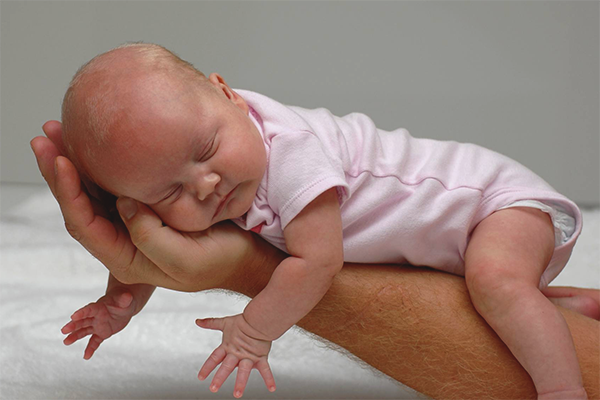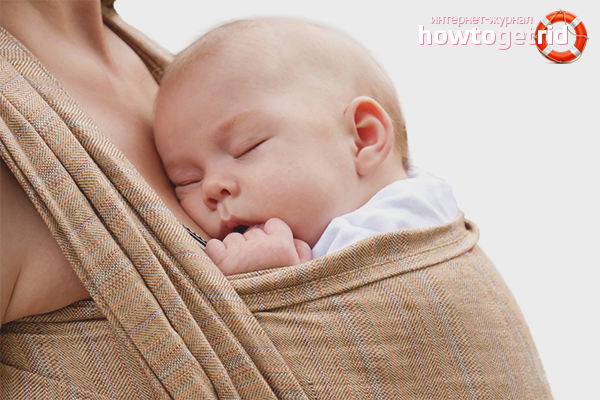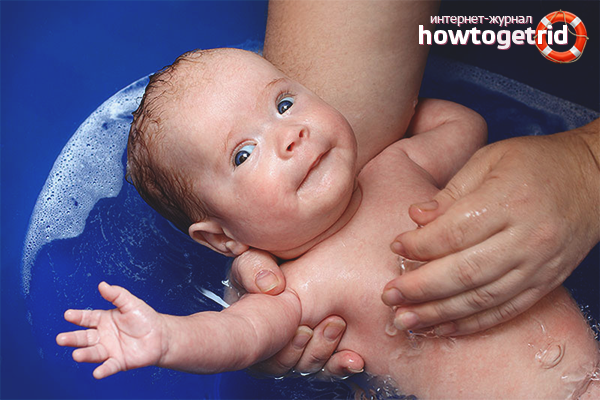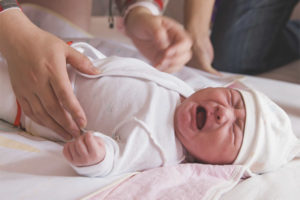The content of the article
After seeing the long-awaited two stripes, my mother begins to prepare for a meeting with a tiny little man. Attends courses, watches educational videos, reads literature. She is confident that she will be able to cope with any difficulties. But having touched fragile hands, the woman forgets about everything. And only one question bothers her at this moment: how to lull and hold a miniature and defenseless baby?
Gentle hugs
Adults who have decided to sharply grab the crumb will have to calm their child’s hysterics for a long time. You need to say hello to babies, tell them a fairy tale or something interesting. You can sing quietly. Babies lying on soft mattresses focus on the ceiling or bright toys, so adults are advised to switch children's attention to themselves.Lean, stroke on the cheek, cover the stomach with a palm. Wait for the crumb to look at mom or dad, and then get him out of the cozy bed.
We must not forget that up to three or even four months the neck of a child does not function. Instead of weak muscles, the parent's fingers should support the head. They are in contact with the back of the head and shoulders, lower back and buttocks. The legs of the baby are located on my father's forearm or my mother's.
The baby turned over on the tummy? Fingers should be wrapped around the chin. To make it easier to fix the head, mom is advised to use a large and medium or index. The second palm is under the rib cage, supports the lower torso. The forearm is inserted under the legs.
The parent rocked the crumb for a long time and now does not know how to return the fragile little man to the cradle and not wake him up? The main thing is not to tear the child from the body. The adult leans towards the mattress itself, pressing the puffing treasure to his chest, and then smoothly lays it on a horizontal surface. Hands remain under the torso of a few seconds. Making sure that the crumb is not going to wake up,the adult gently pulls out the palms and covers the infant. Now you can move away from the cradle and start breathing.
Option for beginners
The crib is an ideal position for parents who do not have enough strength for long motion sickness and feeding. Thanks to this option, the hands get tired more slowly, and the crumb feels comfortable and cozy:
- Lay the miniature head on the bent elbow, putting the fragile body to the shoulders.
- Press the body of the newborn with the forearm to the stomach or mammary glands. The belly of the newborn is in contact with my mother's body. The back rests on the hand of the parent, the palm squeezes the upper part of the legs.
- Slide the second limb under the fifth point and lower back.
The child is constantly turned over from the right side to the left side and vice versa, so that it does not earn the curvature of the cervical vertebrae. Mom is advised to regularly change hands, so they are less tired. In women who load one side more than the other, the back is bent.
The lower and upper extremities of the child are pressed to the body so that they do not dangle in the air. If the mother needs to free one arm to give the baby a breast, she sits down and puts her knees and hips under her heels.
Pose for colic and indigestion
The newborn, who just had lunch, is turned upright. First, the mother grabs the back of the head and chin of the baby with her fingers to fix the head, then lifts it up, putting her palms under the handles.
To lay the forehead and cheeks of the baby on the shoulder, press the body to the chest. One palm move to the back of the head. Fingers gently hold the head in an upright position, gently hugging and not allowing tilting back. Second palm slightly squeeze the back. The spine rests on my mother's forearm, butt rests on a bent elbow. The legs hang down, in this position they do not need to be pressed.
The child is looking, or forward, over his mother's shoulder, with his chin resting on him, or to the side. The newborn is carried around the room, slightly shaking. In the upright position, the baby is from 5 to 15 minutes, not longer.
Due to the post “Stolbik”, excess air comes out of the children's stomach, and intestinal colic bothers the newborn less often. In this position, the baby learns to hold the head on its own. But the immature muscles of the spine can not be overloaded, so after regurgitation and washing the baby is immediately placed in the crib.
Gas assistance
Infants who are more than two weeks old are allowed to turn the belly down. How to take the baby to evenly distribute the load?
- Fingers of one hand to clasp the chest. Index and big to substitute under a chin that the child could lift a head, but she did not fall too low.
- Put your second palm between the legs, putting it under your tummy. The upper and lower extremities of the baby hang freely.
- The child is turned to face the outside world, and its legs to its mother's belly.
The newborn is rocked and carried around the room so that he looks around. Pose is recommended for strong colic, if the baby does not calm down for a long time. Mom's hand gently presses on the tummy, stimulating the exit of gas, and the child's attention switches to surrounding objects, so some babies quickly calm down and calm down.
Prevention of joint dysplasia
After feeding the baby is turned into a vertical position, so that he burped. If your mother's hands are tired, it is recommended to try the Frog pose. The back of a newborn leans against an adult's chest, the head rests on a shoulder.One palm hugs the baby’s tummy, the second one is located below, under the buttocks. Toes hold the feet together. The child’s knees should stick in opposite directions, like a yoga meditator.
Despite the strange appearance, the newborn feels comfortable. It was in this position that he slept in my mother's tummy. In the pose of a meditator, a child’s yoga is seated 2-4 times a day. For the prevention of dysplasia and the normal development of the joints 5-15 minutes is enough, then it is returned to the bed.
How to keep an older baby
Need to quickly move the baby from the cradle to the parents' bed or move from the bedroom to the living room? Tiny babies are transferred in the classic horizontal position, gently supporting the head. Grown up babies that are between 2 and 2.5 months old can be taken by the chest.
Armpits of the newborn run into mom's palms. Her thumbs clasp the breast of the crumbs, and the rest curl around his back. An adult lays the head of a newborn on his shoulder, and presses the small body to the body. Use your forearm or elbow to pin the legs of the infant to the abdomen.
The pose is safe and comfortable, but if the child sits vertically for too long, his spine gets tired. When transferring the baby “column”, you need to monitor the muscles of the neck and securely fix the head so that it does not fall back.
Lifting and transporting four-month babies is easier. In children of this age, the neck muscles become stronger, and they know how to hold their heads on their own. It is possible to rock a crying baby, who does not want to part with his mother, with one hand while the other is resting.
The child sits on the waist of the parent, wrapping her legs. The booty is pressed against the body, and the chest and head of the crumbs are deflected back at an angle of 30–35 degrees. An adult cups the kid's buttocks with his palm, and holds his lower back with his forearm. To be comfortable for the child to sit, he must bend his knees, like a frog, and his heels rest on the belly of his mother or father.
No need to hold baby’s hands. He can put them on the chest of an adult, or squeeze something with small palms.
Bathing position
The child bathing is supported with his left hand.The second, right, newborn is washed and poured from a dipper. Hand and fingers embrace the infant's chest. His head rests on the forearm. The thumb is placed under the spatula or slightly higher.
They wash away babies with warm water, moving from the genitals to the buttocks, so that the feces do not fall on the ureter and genitals. Baby turn belly up. His back rests on Mom's or Dad's forearm. Fingers clasp one thigh, the second hangs down. In this position, the baby's legs are moved apart widely enough and do not interfere with an adult to carry out hygienic procedures.
Important: Wet baby should immediately shift to a towel and squeeze tightly, removing from the bath. The baby’s tender skin is very slippery, and young parents can drop it.
How to do it
- Infants who have not healed the umbilical wound, do not turn over on the stomach. They sleep and rest on their backs. Some babies in a dream roll to the side.
- Grudnichkov forbidden to grab the wrists or lift, squeezing the forearm. You can dislocate the hand, injure the muscles of the hands or fragile children's bones.
- Newborns up to 1-2 months can not be seated buttocks on a hard surface or knees. If the legs hang down from my mother's forearm for too long, the likelihood of curvature of the bones increases.
- We must not forget about the head of the newborn. It is gently supported with fingers or a palm, not allowing to be thrown back. With a sharp fall of the head, muscles and nerves are injured.
- If a child lying in a classic posture has lower and upper limbs hanging down, an additional load is created on the back muscles. Vertebrae can be deformed.
It is recommended to wrap a baby who is too actively waving hands or feet, frightening young parents, in a diaper and then getting it out of the crib. Babies should not be held too tightly or pressed to their chest so as not to damage the fragile bones.
Newborns need and mother's and father's arms, because in the hands of parents warm and safe. Learning to raise and rock a child is easy. Just a few practical exercises will turn a young fighter into a real professional who can support a child’s head and back with one hand, and the second to prepare the mixture and get a diaper.
Video: how to take and keep the baby













To send